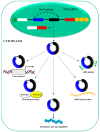Non-Coding RNAs as Potential Diagnostic/Prognostic Markers for Hepatocellular Carcinoma
- PMID: 39596302
- PMCID: PMC11594412
- DOI: 10.3390/ijms252212235
Non-Coding RNAs as Potential Diagnostic/Prognostic Markers for Hepatocellular Carcinoma
Abstract
The increasing incidence of hepatocellular carcinoma (HCC), together with the poor effectiveness of the available treatments, make early diagnosis and effective screening of utmost relevance. Liquid biopsy represents a potential novel approach to early HCC detection and monitoring. The identification of blood markers has many desirable features, including the absence of any significant risk for the patients, the possibility of being used as a screening tool, and the ability to perform multiple tests, thus allowing for the real-time monitoring of HCC evolution. Unfortunately, the available blood markers for HCC have several limitations, mostly related to specificity and sensitivity. In this context, employing non-coding RNAs (ncRNAs) may represent an interesting and novel diagnostic approach. ncRNAs, which include, among others, micro interfering RNAs (miRNAs), long non-coding RNAs (lncRNAs), and circular RNAs (circRNAs), regulate human gene expression via interactions with their target mRNA. Notably, their expression can be altered in HCC, thus reflecting disease status. In this review, we discuss some notable works that describe the use of miRNAs, lncRNAs, and circRNAs as HCC biomarkers. Despite some open aspects related to ncRNA use, the presented works strongly support the potential effectiveness of these molecules as diagnostic/prognostic markers for HCC.
Keywords: circRNA; diagnosis; hepatocellular carcinoma; lncRNA; miRNA; prognosis.
Conflict of interest statement
The authors declare no conflicts of interest. The funders had no role in the design of the study; in the collection, analyses, or interpretation of data; in the writing of the manuscript; or in the decision to publish the results.
Figures




References
Publication types
MeSH terms
Substances
LinkOut - more resources
Full Text Sources
Medical

